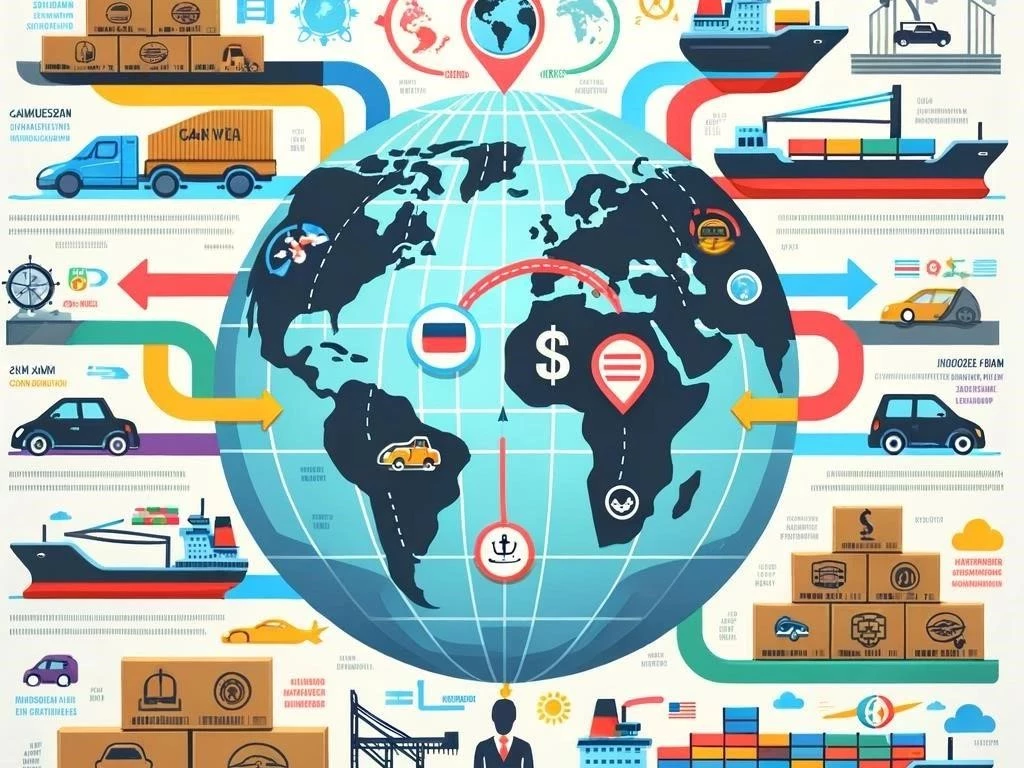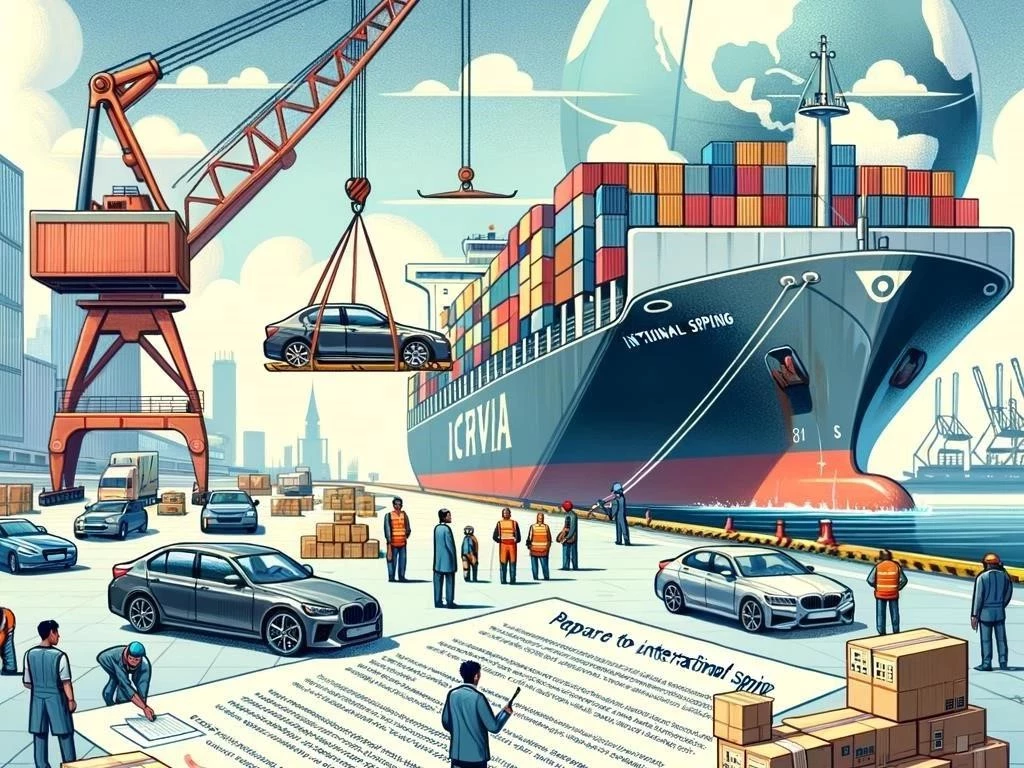Understanding the Basics of International Auto Shipping
Shipping a car overseas involves meticulous planning, understanding logistics, and complying with regulations to ensure vehicle safety and smooth transport from origin to destination.
International auto shipping requires knowledge of shipping options, documentation requirements, customs clearance, and marine shipping methods to successfully transport your vehicle overseas.
What is Car Shipping?
Car shipping refers to the process of transporting vehicles from one location to another, typically over long distances or internationally. This service is vital for individuals relocating, purchasing vehicles from overseas, or moving to different countries. The process includes various methods such as container shipping and Roll-on/Roll-off (RoRo) options. Car shipping involves coordinating logistics, including scheduling, freight forwarding, and selecting the appropriate shipping containers. A crucial aspect of car shipping is ensuring compliance with import regulations and customs clearance procedures. Additionally, it is essential to secure insurance coverage for vehicle safety during transit to mitigate potential risks.
Why Choose Overseas Transport?
Choosing overseas transport for car shipping offers several advantages. It allows individuals to relocate vehicles to different countries conveniently and efficiently. With international auto shipping, you can access a broader market for purchasing vehicles, ensuring you find the perfect match. Additionally, overseas transport provides specialized services tailored to meet the unique needs of vehicle export, such as customs clearance and documentation requirements. With professional freight forwarding services, you can enjoy peace of mind knowing that your vehicle is in safe hands. This method also ensures compliance with import regulations, enhancing the overall reliability and efficiency of car relocation.
Shipping Options for Car Relocation
When relocating a car overseas, options include container shipping, Roll-on/Roll-off (RoRo), and specialized freight forwarding services to ensure safe and efficient transport.
Container Shipping vs. Roll-on/Roll-off (RoRo)
When shipping a car overseas, two primary methods are container shipping and Roll-on/Roll-off (RoRo). Container shipping involves placing the vehicle inside a secure shipping container, offering enhanced protection from environmental elements and potential damage during transit. This option is ideal for high-value vehicles or those requiring extra care. Conversely, RoRo shipping entails driving the vehicle onto a specialized vessel designed for transporting cars. While this method is generally more cost-effective and faster, it exposes the vehicle to the elements. Choosing between these options depends on factors like budget, vehicle type, and desired level of protection during transport.
Freight Forwarding Services
Freight forwarding services play a crucial role in the process of shipping a car overseas; These professionals specialize in coordinating logistics and managing the transportation of vehicles from the point of origin to the destination. They handle various essential tasks, including organizing shipping options, securing shipping containers, and ensuring compliance with customs clearance regulations. Additionally, freight forwarders provide invaluable guidance on documentation requirements and import regulations specific to the destination country. By utilizing freight forwarding services, individuals can streamline the car shipping process, reducing stress and potential delays while ensuring the vehicle’s safety and timely delivery during transit.
Documentation Requirements for Vehicle Export
Exporting a vehicle requires specific documentation, including title, registration, bill of lading, customs forms, and proof of ownership to comply with regulations.
Necessary Paperwork for Customs Clearance
To facilitate customs clearance when shipping a car overseas, several essential documents must be prepared. Firstly, the vehicle’s title and registration are crucial to prove ownership. A bill of lading, issued by the shipping company, outlines the details of the shipment and serves as a receipt. Additionally, customs forms, such as the Import Declaration Form, must be completed accurately. Proof of insurance coverage is also required to ensure vehicle safety during transport. Lastly, any special permits or certifications mandated by the destination country should be gathered to ensure compliance with import regulations and avoid delays.
Import Regulations in Destination Country
When shipping a car overseas, understanding the import regulations of the destination country is essential. Each country has unique rules governing vehicle imports, including age restrictions, emission standards, and safety compliance. Some countries may require modifications to vehicles to meet local regulations, while others have specific documentation requirements. Customs duties and taxes may also apply, impacting the overall shipping costs. Additionally, certain countries may prohibit the importation of specific vehicle types or brands. It is crucial for individuals to research and familiarize themselves with these regulations to avoid penalties, delays, or complications during the import process.
Choosing a Port of Departure
Selecting the right port of departure is crucial for shipping a car overseas, considering factors like location, shipping options, accessibility, and associated costs.
Factors Influencing Your Choice of Port
Several factors influence the choice of a port of departure when shipping a car overseas. Proximity to the origin location is critical, as it can affect transport logistics and costs. Availability of shipping options, such as container shipping or Roll-on/Roll-off (RoRo), also plays a significant role in decision-making. Additionally, the port’s reputation for efficiency and reliability can impact overall delivery times. Customs clearance processes at the port should be considered, as well as any associated fees. Lastly, the port’s connectivity to the destination country can influence transit times and overall shipping costs, affecting the entire experience.
Understanding Shipping Containers and Their Use
Shipping containers are essential for transporting cars overseas, providing a secure and protective environment for vehicles during transit. These containers come in various sizes, typically 20 or 40 feet long, to accommodate different vehicle dimensions. When using container shipping, vehicles are loaded inside these containers, which are then sealed to prevent damage from weather and external factors. This method enhances vehicle safety, particularly for high-value or classic cars. Additionally, container shipping allows for better organization of cargo and can include multiple vehicles in one container. Understanding container specifications and proper loading techniques is crucial for a successful shipping experience.
Calculating Shipping Costs and Insurance Coverage
Accurately calculating shipping costs involves considering factors such as distance, shipping method, vehicle size, and insurance coverage to ensure comprehensive financial planning.
Factors Affecting Shipping Costs
Several factors significantly influence shipping costs when transporting a car overseas. The distance between the origin and destination plays a crucial role, as longer journeys typically incur higher fees. The chosen shipping method, such as container shipping or Roll-on/Roll-off (RoRo), also affects pricing, with container shipping generally being more expensive due to added security. Vehicle size and weight impact costs, as larger vehicles require more space and resources. Additional expenses may include customs duties, port fees, and insurance coverage. Lastly, fluctuations in fuel prices can influence overall shipping costs, making it essential to obtain accurate quotes before shipping.
Understanding Insurance Coverage for Car Shipping
Insurance coverage for car shipping is essential to protect your vehicle during transit. When shipping a car overseas, it is crucial to understand the different types of insurance options available. Most shipping companies offer basic coverage, which may only cover a portion of the vehicle’s value. Comprehensive insurance, on the other hand, provides broader protection against damages, theft, or loss during transit. It is vital to assess the vehicle’s value and any potential risks associated with the shipping method chosen. Always read the insurance policy carefully, noting any exclusions and limitations, to ensure adequate protection throughout the shipping process.

Transport Logistics and Delivery Times
Understanding transport logistics is crucial for shipping cars overseas, as it directly impacts delivery times, routes, and overall efficiency in the shipping process.
Estimating Delivery Times for Overseas Transport
Estimating delivery times for overseas transport involves several factors that can affect the overall shipping duration. The distance between the port of departure and the destination port is a primary consideration, as longer distances typically result in extended transit times. The chosen shipping method, whether container shipping or Roll-on/Roll-off (RoRo), also influences delivery timelines, with RoRo generally being faster. Weather conditions, port congestion, and customs clearance procedures can further impact estimated delivery times. Additionally, it is essential to account for potential delays during loading and unloading processes. Communicating with the shipping company can provide more accurate timelines.
Vehicle Safety During Transit
Ensuring vehicle safety during transit is a critical aspect of shipping a car overseas. Proper preparation is essential; this includes securing the vehicle inside a shipping container or on a RoRo vessel. Using wheel chocks and securing straps helps prevent movement during transport, reducing the risk of damage. Additionally, thorough inspections before shipping can identify pre-existing issues, ensuring they are documented. It is also advisable to choose reputable shipping companies that prioritize vehicle safety and offer adequate insurance coverage. Lastly, maintaining communication with the shipping provider throughout the process can help monitor the vehicle’s status and address any concerns promptly.
Car Handling and Post-Arrival Procedures
After arrival, proper car handling and procedures ensure vehicle safety, compliance with local regulations, and smooth retrieval, facilitating a seamless transition to ownership.
Preparing Your Car for Shipping
Preparing your car for shipping overseas is crucial to ensure a smooth transport process. Start by cleaning the vehicle, as this allows for easier inspections and helps document the car’s condition. Remove personal belongings, as shipping companies typically prohibit items inside the vehicle during transit. Check for any leaks or mechanical issues, and ensure that the fuel tank is no more than a quarter full. Disable any alarm systems to prevent unnecessary disruptions during shipping. Finally, take photographs of the vehicle from multiple angles to document its condition before shipping, which will be useful for insurance purposes if needed.
What to Do Upon Arrival
Upon arrival of your car overseas, several essential steps should be taken to ensure a smooth retrieval process. First, inspect the vehicle thoroughly for any damage that may have occurred during transit. Compare its condition to the pre-shipping photographs taken earlier. Next, gather all necessary documents, including the bill of lading, customs clearance paperwork, and proof of insurance. Proceed to the customs office to complete any required paperwork and pay applicable duties or taxes. Once cleared, arrange for transportation from the port to your desired location. Finally, familiarize yourself with local regulations regarding vehicle registration and compliance.
Making Your Car Shipping Experience Smooth
To ensure a smooth car shipping experience overseas, thorough planning and preparation are essential. Begin by researching reputable shipping companies that offer the best services and insurance coverage. Understand the documentation requirements and import regulations relevant to your destination country. Choose the appropriate shipping method that meets your needs, whether container shipping or Roll-on/Roll-off. Properly prepare your vehicle for transit and be aware of post-arrival procedures to facilitate a seamless transition. By staying informed about logistics, delivery times, and customs clearance, you can minimize delays and potential issues, making your car shipping experience efficient and stress-free.








